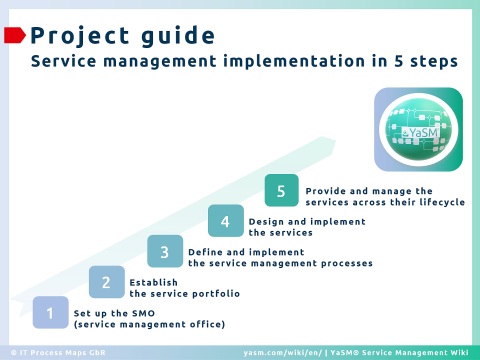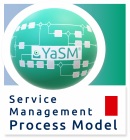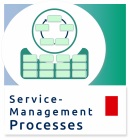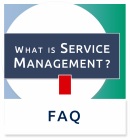Service Management Project - Roadmap
Here we present a roadmap for organizations that seek to improve their service management. The roadmap describes the key steps of setting up and executing a service management implementation project.
Unfortunately there is no one approach to adopting service management best practices that works for every organization. The details of the project steps required will depend on your current situation and specific objectives. But we can provide this high-level description of a service management implementation roadmap that will be usable across a wide range of diverse organizations.
Note: The example documents used in this roadmap are from Jack's Hiking Gear, a fictitious company. We have invented Jack's to showcase how service management works in practice.

Watch the video:
- Where to start with service management? (12:05 min.)
A high-level roadmap that shows the steps required to bring the service management guidance to life in your organization.
Set up the SMO (service management office)

Coordination of all service management activities in the organization.
Every service management journey should begin with identifying the individual or team who is in charge of the whole effort, and many organizations have found that establishing a service management office (SMO) is perfect for overseeing service management initiatives.
The service management office is typically a smaller group of people who
- set policies and standards,
- train service practitioners,
- set up and manage service management initiatives, and
- support the provision of high-quality services within the organization.
The SMO is also a hub for managing and sharing information, so the process of establishing a service management office will usually include the selection and setup of a collaboration platform where service management practitioners communicate and share information (see fig. 1).
In one of our videos we take a closer look at the concept of the service management office and how Microsoft® Teams can be used as a collaboration platform the for the SMO:
- Video: "Service Management Office (SMO) and YaSM".
Train SMO staff and service management practitioners
Obviously, the key players will need a good understanding of service management best practices.
A good starting point is this YaSM Wiki, and you may also want to encourage SMO staff and service management practitioners in your organization to get trained in one of the popular service management frameworks such as ITIL®, SIAM™ or FitSM.
Establish the service portfolio
Service management is all about providing high-quality services to your customers, so before you start to think about service management processes and tools, you need to understand the needs of your customers.
One of the first tasks of any newly established SMO should thus be to compile a list of services (the "service portfolio").
How to create your initial service portfolio
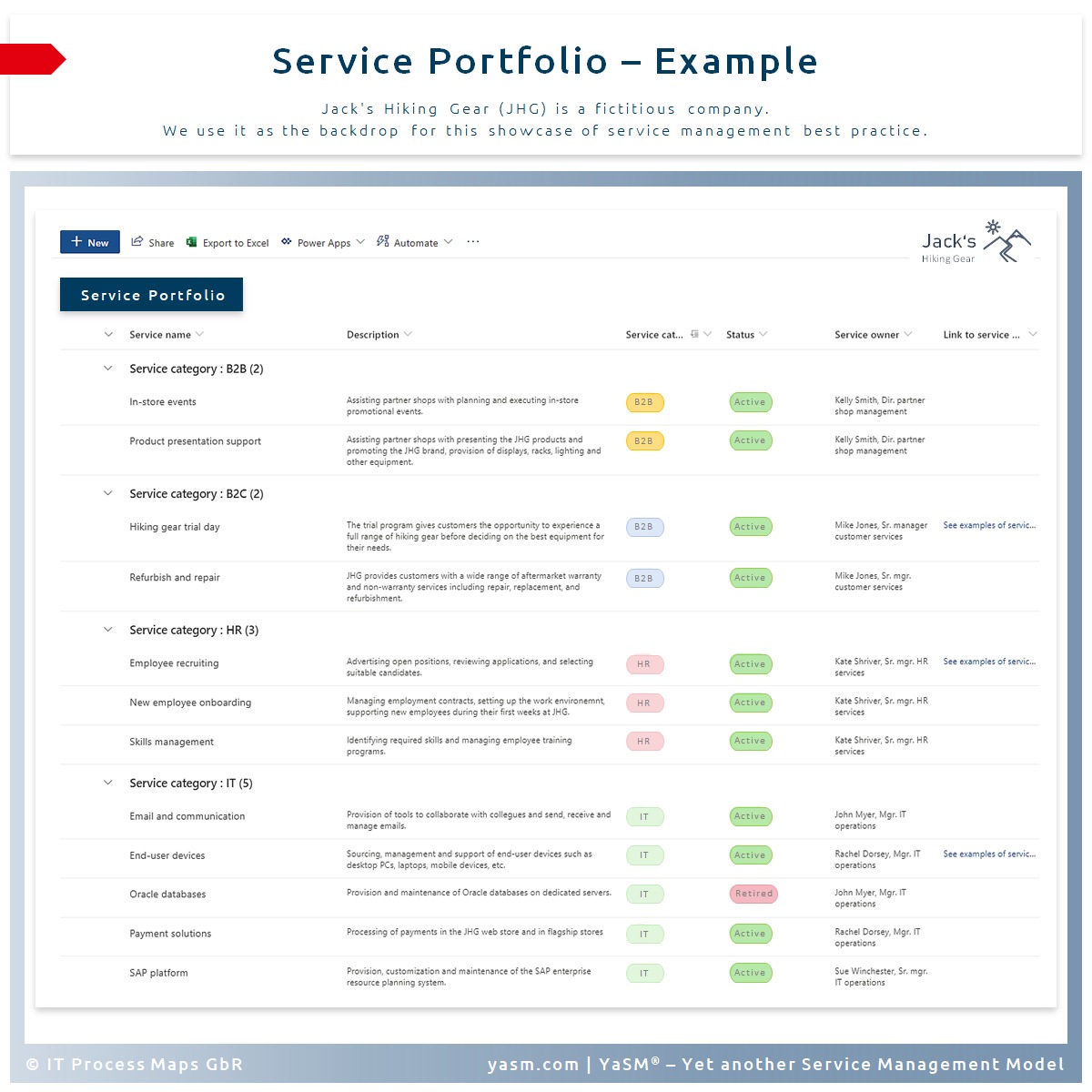
The core repository for information about services in the organization.
Unfortunately, many service providers often do not understand the range and value of services they provide. But here are some tips for creating the initial service portfolio:
- Assess customer-facing activities and determine if some of those activities would benefit from being set up as properly managed services.
- Map out customer journeys to work out which services are needed to create the perfect customer experience,
- Identify candidates for services among business processes, such as HR processes that can be streamlined and converted to shared services.
From a technical perspective, there are many ways of setting up a service portfolio, for example
- Service portfolio management tools in platforms such as ServiceNow, Remedy, etc.
- Lists or tables in corporate wikis or intranets.
- Lists on SharePoint®- sites (see fig. 2).
Whatever the format, your service portfolio should contain key information about services such as service name, description, status, service owner, and a link to more detailed information about each service.
Customer journey maps
A customer journey map is a visual representation of a customer's experience with a business. These visuals tell a story about how a customer moves through each phase of interaction, spanning each step from the initial engagement to a long-term relationship (see fig. 3).
Customer journey maps can also be used to focus on the experience of a user, an employee, a citizen, a client, a patient, etc. They help organizations to identify opportunities for improvement
Journey maps are perfect for visualizing how enhanced customer services contribute to great customer experiences, and are thus a good starting point when developing your service portfolio.
Define and implement the service management processes
Once the customer needs and services have been identified, you can take the next step and design the processes required to manage those services.
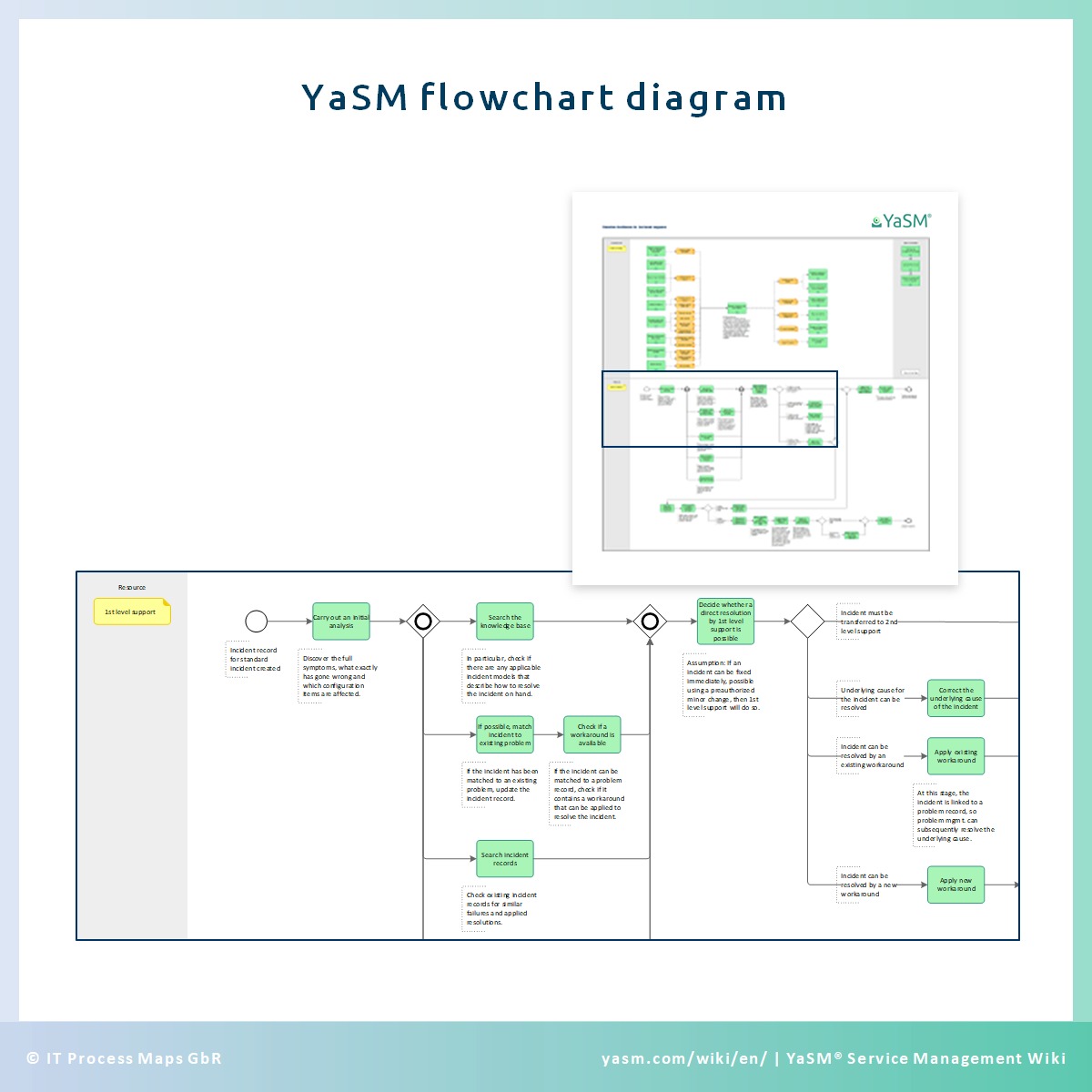
Flowchart diagrams describe the service management process activities.
Processes are often documented in the form of flowchart diagrams (fig. 4). These should provide a clear idea of the required activities and their sequential order, without going into unnecessary detail. The diagrams will also specify the roles responsible for executing the activities.
The processes, practices and other guidance included in the popular service management frameworks are an essential input for this step, and to get you started quickly we have translated the key elements of this guidance into a clear-cut, streamlined set of 19 service management processes.
Each process should have a defined owner. Process owners are responsible for managing a process from end-to-end, and a RACI matrix is the perfect tool for assigning process ownership to key employees.
A RACI matrix (see example: fig. 5) also helps to clearly define and communicate roles and responsibilities.
Introduce service management processes in stages
Most organizations will not implement all service management processes at once, and the ones you choose first will depend on your specific objectives and pain points.
If, for example, your aim is to ensure excellent customer support, your focus should be on the incident and service request resolution process, and possibly the problem resolution process to take care of deeper-running problems.
If your aim is to lay the groundwork for the adoption of service management best practice, your initial focus should be on the five service lifecycle processes. You can then add supporting processes at a later point in time, as needed.
Save time and effort with the templates included in YaSM Process Map
The process and document templates included in the YaSM Process Map simplify your task of designing processes that are aligned with service management best practice. Adapting existing content is much faster than having to start with a blank page.
If there are existing service management processes in your organization already, you can use the YaSM model to assess these processes and identify potentials for improvement.
You can also benchmark your existing processes against ISO 20000, the international standard for service management.
Integrating the service management processes into your existing process architecture

Service management processes integrated into the existing process landscape.
Unless you start up a new business, your organization will most likely have defined and documented processes in various areas, such as marketing, sales, manufacturing, finance, IT, etc.
Obviously, any new processes introduced for better management of services will need to be integrated into the existing process landscape, as in our example of a top-level business process architecture (fig. 6). The processes highlighted in green are processes for the development and delivery of services from the YaSM model that the organization has added to its core processes.
Design and implement the services
Now all elements are in place to start the detailed design, or re-design, of your services. The service design process included in the YaSM model describes the typical steps, so you can use it as a guideline.
Service models to focus on the larger understanding of a service

Example of HR service: Employee recruiting.
Service design often begins with the creation of a service model - a visual representation of how a service creates value for the customer. Service models typically describe user actions, touchpoints, onstage and backstage actions by the service provider, and the underlying processes supporting the service (see fig. 7).
Service-specific processes
You may also have to define service-specific processes. For example, an HR department providing an employee onboarding service will usually follow a well-defined process that describes activities, inputs and outputs, as well as responsibilities.
Other key outputs from the service design process are
- service definitions, specifying service utility, warranty and other service properties, and
- service implementation blueprints, describing the approach to implementing the new or upgraded services.
As for implementing new services, the activities to be performed will depend on the nature of the services and the organization's baseline situation. In general, implementing services will include
- setting up tools, applications and other required infrastructure
- procuring externally provided supporting services
- training people involved in providing the services
- creating or updating service operation manuals
- etc.
Provide and manage the services across their lifecycle
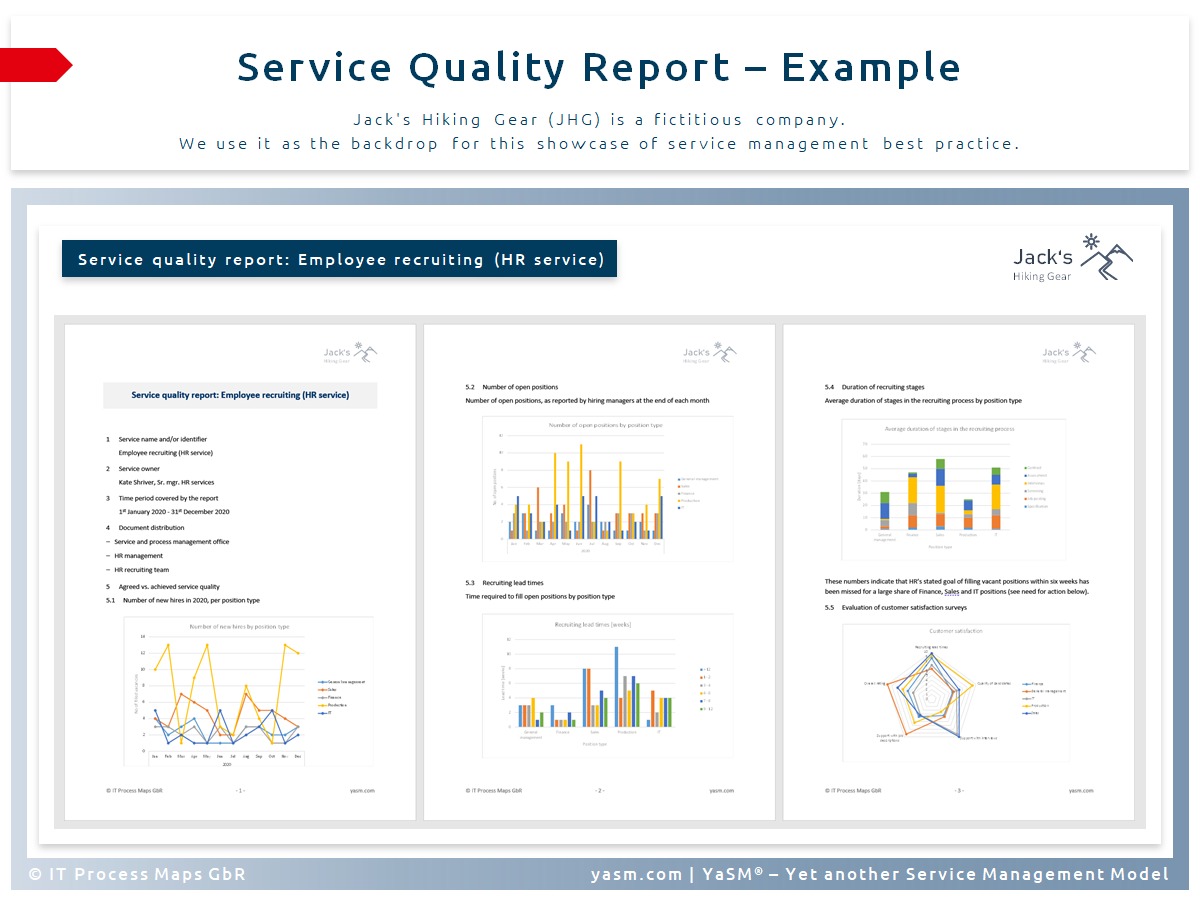
Example of HR service: Employee recruiting.
Now that the services are operational and ready to be used by customers, you need to ensure that those new or modified services will be provided as promised and meet all of their agreed targets. This includes service operation activities such as
- monitoring services
- resolving service incidents and service requests
- analyzing and resolving problems
- performing routine operational tasks
- collecting data and information that are essential inputs for continual service improvement.
A key output from service operation are service quality reports, which report on the service levels achieved in relation to agreed targets (see fig. 8).
You - or the service owners - should use these reports, and other information such as customer feedback, to identify and implement service improvements.

Service improvements are typically managed through a service improvement plan (SIP), which can be a simple list outlining improvements, target dates and responsibilities, or some kind of Kanban board as in fig. 9.
If a new (or substantially changed) service is needed, you begin once again with the service design stage and start the next iteration of the service lifecycle.
For all of these activities, and the documents and records resulting from these activities, you will find process and document templates in the YaSM service management model.
Notes
By: Stefan Kempter ![]() and Andrea Kempter
and Andrea Kempter ![]() , IT Process Maps.
, IT Process Maps.
Set up the SMO › Establish the service portfolio › Define and implement processes › Design and implement services › Provide and manage services

